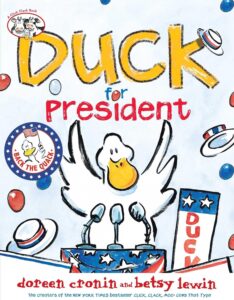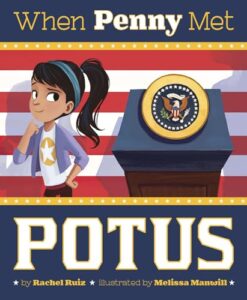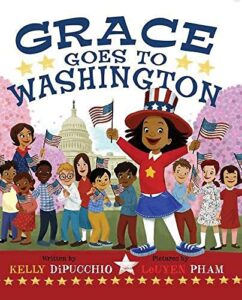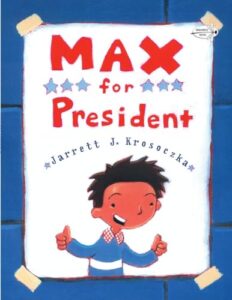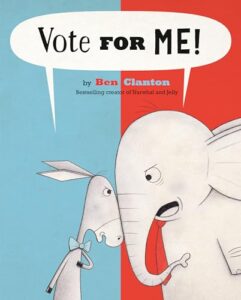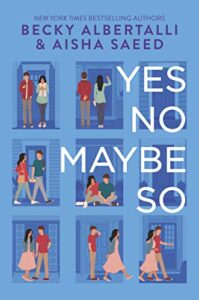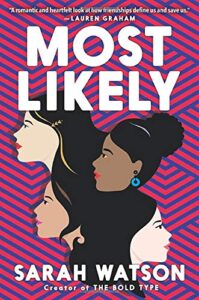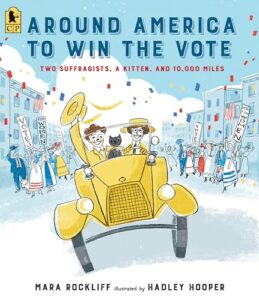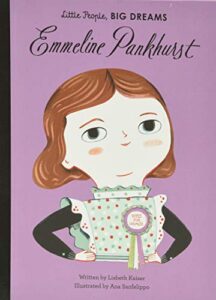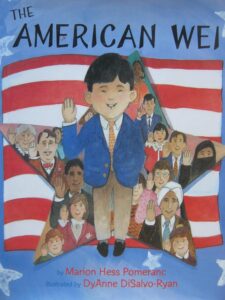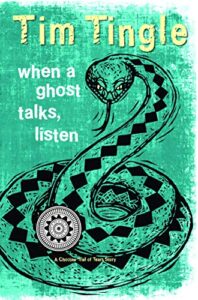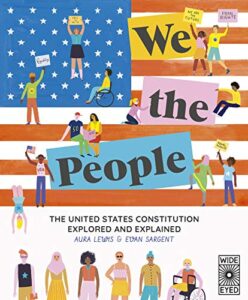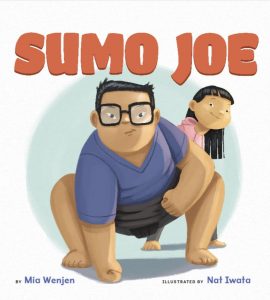The United States was founded on principles of equality, justice, and the pursuit of happiness, but not everyone was allowed to vote when the country was founded. In fact, it would be centuries before all its citizens became eligible to vote.
Voter suppression continues in many forms even today here in the United States. Unlike countries like Canada where every eligible citizen votes by mail, the United States still has voter registration purges, voting polling deserts, requests for mail-in ballots that are not fulfilled, and a lack of mail-in ballots during the time of the COVID-19 pandemic that makes it dangerous and even potentially lethal for some people to vote.
It’s easy to portray voting for children’s books as an equitable process that existed since our country was founded but I think that does an injustice to our history and to children’s intelligence. After all, if kids are our future, they need to know about the blemishes in our past.
How about you? What are your favorite children and young adult books about voting and the election process? Thanks for sharing!
25 Voting and Election Children’s Books
Future President by Lori Alexander, illustrated by Allison Black
Baby learns about what it means to be the U.S. president and realizes that baby has the skills to be an effective president! Fun Facts in the back give more information on the president’s responsibilities. Bright and colorful illustrations make this a visual treat. I also appreciated the depiction of babies of all ethnicities! [board book, ages 1 and up]
Duck for President by Doreen Cronin, illustrated by Betsy Lewin
This is our favorite picture book to learn about the election process as Duck works its way from duck to farmer to governor, and now is running for the highest office as president of the United States. The humor keeps kids engaged but this picture book also shows the trajectory that many politicians take to run for president. Duck has shown in the past via Click Clack Moo that Duck is an effective activist. It won’t surprise me that Duck runs a tight campaign! [picture book, ages 4 and up]
Grace for President by Kelly DiPucchio, illustrated by LeUyen Pham
To become the first U.S. female president, Grace decides to start by running in her class’s mock election. It’s a battle of the sexes and her opponent is running on the slogan that he’s the best “man” for the job and has the votes of all the boys in her class. This is a great picture book to learn about the electoral process and to discuss why the U.S. has not had a female leader, unlike many other countries in the free world. [picture book, ages 4 and up]
When Penny Met POTUS by Rachel Ruiz, illustrated by Melissa Ann Manwill
by Rachel Ruiz, illustrated by Melissa Ann Manwill
Pair Grace for President with this picture book that has a surprise ending. It might reveal that we are conditioned to accept gender roles in leadership positions. [picture book, ages 4 and up]
Grace Goes to Washington by Kelly DiPucchio, illustrated by LeUyen Pham
Grace is back and she is learning how the three branches of the U.S. government work as she and her class travel to Washington D.C. Grace ponders if she is ready to become a public servant, as she would be as president of the United States. [picture book, ages 4 and up]
If I Ran for President by Catherine Stier, illustrated by Lynne Avril
This picture book goes into more depth about the U.S. election system including political parties, the primary process, and the campaign platforms. Learn what it takes to run for president in this informative and realistic portrayal of a candidate running for U.S. president. [picture book, ages 4 and up]
My Teacher for President by Kay Winters, illustrated by Denise Brunkusby
Babies and teachers, it turns out, have the skills from real life to be a great president. Pair this book with Future President, especially if you have preschool and elementary school-aged kids and want books to read and compare for both of their age groups. [picture book, ages 4 and up]
Max for President by Jarrett J. Krosoczka
Pair this with Grace for President for a boy versus girl perspective of kids running for class president. [picture book, ages 4 and up]
 Vote for Me by Ben Clanton
Vote for Me by Ben Clanton
Donkey and Elephant duke it out, election style, as they campaign. They stoop to mudslinging, bribery, and family connections to win votes. Who wins? Well, you’ll just have to read the story! [picture book, ages 4 and up]
What’s the Big Deal About Elections? by Ruby Shamir, illustrated by Matt Faulkner
History and trivia are presented in a fun way in this nonfiction picture book about elections. This book touches on the voter suppression of Native Americans and covers why voting is so important. It’s a nice overview of our election history and process. [picture book, ages 6 and up]
Yes No Maybe So by Becky Albertalli and Aisha Saeed
Jamie Goldberg, who is Jewish, and Maya Rehman, who is Muslim, are an unlikely political activist pairing. Jamie prefers to stay behind the scenes after an unfortunate interview incident involving vomiting. Maya has no interest in political canvassing, especially with a boy she hardly remembers from preschool. But, as they work together, canvassing door-to-door to win support for their candidate, they find that there is a lot more at stake than they realize. [young adult, ages 14 and up]
Most Likely by Sarah Watson
Review by Children’s Books Heal:
“Most Likey is a timely, empowering, and suspenseful political novel for teens and young adults. The story’s heart is rooted in strong female friendships and self-discovery that make this story soar. Sarah Watson’s writing is uplifting and her novel is the perfect summer escape!
The narrative is written in the third person with each chapter rotating four different viewpoints. It held me back a bit because I couldn’t keep the details of each of the teens’ lives straight until I reached the halfway point. By then I was hooked and I couldn’t put the book down.
The character-driven plot weaves together the realistic and complicated lives of the four seniors who are ethnically diverse and from different socioeconomic backgrounds. They tackle a variety of issues in their lives, ranging from depression, adoption, fears of not being good enough, sexual orientation, divorce, and concerns about being able to afford college. And they have a male friend, Logan Diffenderfer, who has a unique relationship with each of the besties. Although Logan is not the story, he is a grounding force for the four teens.
The Prologue gives readers a peek into the future — Washington DC on Jan. 20, 2049, the day of the presidential inauguration. Readers are only given one clue. The president-elect’s last name is Diffenderfer. The actual story is set in 2019 -2020 in Cleveland, Ohio, with the seniors focused on grades, relationships, work, SAT scores, college applications, loans, and community service. The Epilogue fast-forwards to the inauguration day, the big reveal, and a satisfying ending about the other three best friends, who are all present. Sorry. I can’t give anything away.” [young adult, ages 12 and up]
When Did Women Win the Right to Vote?
Passed by Congress June 4, 1919, and ratified on August 18, 1920, the 19th amendment granted women the right to vote. from OurDocoments.gov
Abigail Adams by Alexandra Wallner
With limited means for influence, Abigail Adams nevertheless persisted in furthering women’s rights and the abolition of slavery in her own household. As the wife of the United States’ 2nd president and mother of the U.S.’s 6th president, she was at the center of politics. It’s through her letters that we are able to see the work that she did and two thousand of them have survived. The folk art illustrations pair nicely with the prose that captures her life with gentle dignity. [picture book biography, ages 5 and up]
Ida B. Welles Marches for the Vote by Dinah Johnson, illustrated by Jerry Jordan
The suffragist battle for women to vote was not an inclusive one. White women fought for their right to vote, but at the National American Woman Suffrage Association parade, one of the organizers, Alice Paul, did not want to include women of color. Ida B. Welles had fought for civil rights all of her life and she did not let Alice Paul’s racism stop her. She marched for the vote at the front of the parade. [picture book biography, ages 5 and up]
Bold & Brave: Ten Heroes Who Won Women the Right to Vote by Kirsten Gillibrand, illustrated by Maira Kalman
Senator Kirsten Gillibrand highlights ten female suffragists who fought for the right to vote: Elizabeth Cady Stanton, Susan B. Anthony, Sojourner Truth, Harriet Tubman, Jovita Idár, Alice Paul, Inez Milholland, Ida B. Wells, Lucy Burns, and Mary Church Terrell. [picture book, ages 6 and up]
Lucy Stone, Suffragist left out of history
The Ballot Box Battle by Emily Arnold McCully
It wasn’t that long ago when women in the United States were not allowed to vote, and Cordelia learned a little from her neighbor, the great suffragist Elizabeth Cady Stanton. As Stanton shares her story of how she was treated when she fought for the right to vote for women, Cordelia is inspired to an act of courage as well. [picture book, ages 6 and up]
Around America to Win the vote: Two Suffragists, a Kitten, and 10,000 Miles by Mara Rockliff, illustrated by Hadley Hooper
In 1916, Nell Richardson and Alice Burke drove across America to advocate for women’s voting rights. This was during a time when roads weren’t paved, and driving was an adventure. The endnote puts it into perspective: “Alice and Nell’s journey may have sounded long and hard, but it was quick and easy compared to the journey American women undertook to win the vote.” [picture book, ages 5 and up]
Emmeline Pankhurst (Little People, BIG DREAMS) by Lisbeth Kaiser, illustrated by Ana Sanfelippo
Emmeline was born into privilege, but at a young age, became an activist advocating for women’s rights including the right to vote. Her daughters joined her in this lifelong fight both in England and in the United States. it wasn’t until after WWII that Emmeline and her suffragette army achieved success. [picture book, ages 5 and up]
No Steps Behind: Beate Sirota Gordon’s Battle for Women’s Rights in Japan by Jeff Gottesfeld, illustrated by Shiella Witanto
Beate Sirota Gordon grew up in Japan when her parents immigrated to escape anti-Semitic Russia in 1929. Because she was fluent in Japanese and understood the culture, Beate, at age 22, drafted part of the new Japanese constitution after WWII. She fought for equal rights including women’s rights. The rights that she proposed were more progressive than in the United States at the time, and she succeeded in getting them passed. Women in Japan are now guaranteed equal rights thanks to Beate and the United States still does not have this provision for women today. [picture book biography, ages 8 and up]
When Did Asian Americans Win the Right To Vote?
The Chinese Exclusion Act of 1882 was the first significant law restricting immigration into the United States.
The Chinese Exclusion Act of 1882 suspended Chinese immigration for ten years and declared Chinese immigrants ineligible for naturalization. President Chester A. Arthur signed it into law on May 6, 1882.
American experience with Chinese exclusion spurred later movements for immigration restriction against other “undesirable” groups such as Middle Easterners, Hindu and East Indians, and the Japanese with the passage of the Immigration Act of 1924.
Chinese immigrants and their American-born families remained ineligible for citizenship until 1943 with the passage of the Magnuson Act.
from History.com
The American Wei by Marion Hess Pomeranc, illustrated by Dyanne Disalvo-Ryan
It’s a big day for Wei Fong. Today, he and his family will become United States citizens! The day is especially lucky because he has his very first loose tooth and he’s hoping the Tooth Fairy will come tonight. Calamity strikes when Wei loses his tooth in front of the Federal Courthouse where they are to be sworn in. Luckily people of all races and nationalities pitch in to help Wei find his tooth, and they make it just in time for their ceremony. It’s the best day ever! [picture book, ages 4 and up]
When Did African Americans Win the Right To Vote?
The 15th Amendment granted black men the right to vote under the law, but exercising that right became another challenge.
… in 1865-66, most Southern state legislatures enacted restrictive laws known as black codes, which strictly governed black citizens’ behaviors and denied them suffrage and other rights.
Early in 1866, Congress passed the Civil Rights Bill, which aimed to build on the 13th Amendment and give black Americans the rights of citizens.
The 14th Amendment, approved by Congress in 1866 and ratified in 1868, granted citizenship to all persons “born or naturalized in the United States,” including former slaves, and guaranteed “equal protection of the laws” to all citizens.
While the 15th Amendment barred voting rights discrimination on the basis of race, it left the door open for states to determine the specific qualifications for suffrage. Southern state legislatures used such qualifications—including literacy tests, poll taxes and other discriminatory practices—to disenfranchise a majority of black voters in the decades following Reconstruction.
In the 1950s and ‘60s, securing voting rights for African Americans in the South became a central focus of the civil rights movement. While the sweeping Civil Rights Act of 1964 finally banned segregation in schools and other public places, it did little to remedy the problem of discrimination in voting rights.
In 2013, the Supreme Court struck down a key provision of the Voting Rights Act, ruling 5-4 in Shelby v. Holder that it was unconstitutional to require states with a history of voter discrimination to seek federal approval before changing their election laws. In the wake of the Court’s decision, a number of states passed new restrictions on voting, including limiting early voting and requiring voters to show photo ID. Supporters argue such measures are designed to prevent voter fraud, while critics say they—like poll taxes and literacy tests before them—disproportionately affect poor, elderly, black and Latino voters.
from History.com
While the act [Voting Rights Act of 1965] intended to overcome legal barriers at the state and local levels that prevented African Americans in particular from employing their right to vote, the law was far-reaching, securing this right for most racial and ethnic minorities, including English-speaking Latinos in the southwest, northeast, and southeast…
Lillian’s Right to Vote: A Celebration of the Voting Rights Act of 1965 by Jonah Winter, illustrated by Shane W. Evans
Lillian’s Right to Vote: A Celebration of the Voting Rights Act of 1965 by Jonah Winter & Shane W. Evans
How many bubbles are in a bar of soap? Name all sixty-six judges in the state of Alabama.
These “tests” were forced on African Americans to prevent them from voting prior to the Voting Rights Act.
In 2008, at age one hundred, Lillian Allen campaigned for Barack Obama. Her efforts to bring in voters also portray the symbolic struggle for voting rights that African Americans had to overcome: slavery, poll tax, ridiculous and impossible trivia tests, angry mobs, KKK threats, and police violence. [advanced picture book, ages 5 and up]
This book is in commemoration of the fiftieth anniversary of the Voting Rights Act. In 2014, the Supreme Court struck down a key provision of the Voting Rights Act of 1065, allowing states to create “voter ID laws” that require all citizens to present a state-issued ID when voting, even though this is a financial obstacle for the poor and elderly to obtain.
Granddaddy’s Turn: A Journey to the Ballot Box by Michael S. Bandy and Eric Stein, illustrated by James E. Ransome
This is the true story of voter repression that happened to Michael’s grandfather when he attempted to vote for the first time. Years later, Michael pays tribute to his grandfather as he casts his vote. [picture book, ages 6 and up]
When Did Native Americans Win the Right To Vote?
Native people won citizenship in 1924, but the struggle for voting rights stretched on much longer.
Native Americans couldn’t be U.S. citizens when the country ratified its Constitution in 1788, and wouldn’t win the right to be for 136 years.
When black Americans won citizenship with the 14th Amendment in 1868, the government specifically interpreted the law so it didn’t apply to Native people. from History.com
I would love to add children’s books that touch on or cover this topic. Thank you for your suggestions!
Latinx Voters and Other Non-English Speakers and Their Right to Vote
“In 1974, the Southwest Voter Registration Education Project, the first and largest non-partisan Latino voter participation organization in the US, started operations, with founder William C. Velasquez, and other Mexican-American political activists, discovering early that, despite the achievements of the Voting Rights Act of 1965, there remained barriers – particularly, language – for Latino voters preventing them from exercising their right…
The Voting Rights Act of 1965 included a section that ensured that people educated in US schools that were predominately taught in a language other than English – for instance, island Puerto Ricans – could not be denied the right to vote because of their inability to read, write, understand, or interpret material in English, Spanish-speakers in the contiguous US, including mainland Boricuas, were often still discriminated against at the polls. This changed on August 6, 1975, exactly one decade after the Voting Rights Act of 1965, when, following several court battles on behalf of Latino Americans, President Gerald Ford amended the act to also end discrimination against so-called “language minorities.” Protecting the voting rights of Latinos, as well as non-English-speaking Asian Americans and Native Americans, made it possible to translate registration materials into other languages and strengthened the political power of communities of color…
In 1992, when the bilingual election requirement was close to expiring, Rep. José E. Serrano (D-NY) introduced the Voting Rights Language Assistance Act of 1992, legislation that aimed to extend the provision for 15 years, meaning it would expire in 2007 like the other special provisions…
Since 2010, communities of color have seen voting restrictions increase, particularly in the form of strict photo ID requirements, like in Texas, Wisconsin, and North Carolina, to early voting cutbacks, as seen in Florida, to other registration restrictions…
A 2018 poll conducted by the Public Religion Research Institute (PRRI) and The Atlantic shows how these new qualifications and the loss of protections are leading to voter suppression, with Black and Latino voters facing more barriers at the voting booth. According to poll findings, 9 percent of Latino respondents, compared to 3 percent of whites, say that they (or someone in their household) were told that they lacked the proper identification to vote in the last election. Similarly, 11 percent of Latino respondents, compared to 5 percent of whites, reported that they were incorrectly told that they weren’t listed on voter rolls. In all, the poll found that Black and Latino respondents were twice as likely, or more, to have experienced barriers as their white respondents. A 2018 poll conducted by the Public Religion Research Institute (PRRI) and The Atlantic shows how these new qualifications and the loss of protections are leading to voter suppression, with Black and Latino voters facing more barriers at the voting booth. According to poll findings, 9 percent of Latino respondents, compared to 3 percent of whites, say that they (or someone in their household) were told that they lacked the proper identification to vote in the last election. Similarly, 11 percent of Latino respondents, compared to 5 percent of whites, reported that they were incorrectly told that they weren’t listed on voter rolls. In all, the poll found that Black and Latino respondents were twice as likely, or more, to have experienced barriers as their white respondents.
from Remezcla
Books for Kids about Presidents and the Constitution
John Trumbull’s 1818 oil painting “Declaration of Independence,” with red dots on the faces of all the men who owned slaves. Provided by Arlen Parsa.
Is this true? Fact checked by Chicago Sun-Times.
The Next President: The Unexpected Beginnings and Unwritten Future of America’s Presidents by Kate Messner, illustrated by Adam Rex
Kate Messner examines what fifty-five U.S. presidents did before being elected to the highest office. Conversational in tone, this is a light-hearted look that suggests that anyone can be president; it’s not necessarily a job that someone aspires to as a child. I also appreciated her point on diversity in this position; there isn’t much. [advanced nonfiction picture book, ages 8 and up]
p.s. Not all presidents are viewed in a positive light when examined from a historical perspective. To learn more about Andrew Jackson, for example, pair this book with When a Ghost Talks Listen by Tim Tingle.
We The People: The United States Constitution Explored and Explained by Aura Lewis and Evan Sargent
For kids who want to learn more about the U.S. Constitution, this fact-filled book breaks it down in an interesting way that kids can relate to. This is a great resource to have in a classroom or library and for any future attorneys who will one day study constitutional law. Amendments in the Bill of Rights associated with voting include the 12th Amendment (Electoral College), 15th Amendment (voting rights), 17th Amendment (voting for senators), 19th Amendment (votes for women), 22nd Amendment (two-term limit on the President), 24th Amendment (abolition of poll tax), and 26th Amendment (right to vote at age 18). [advanced nonfiction picture book, ages 10 and up]
Games for Kids About Presidential Election
Free games on the Constitution from PBS:
Free Games on the Election:
The Presidential Game
My 7-year-old son likes board games so he makes me play them with him as his sisters will generally not play board games with or without him. With the upcoming presidential election, I thought it might be a good way to explain the United States’ slightly convoluted election process to him.
The most daunting thing for me is to figure out the rules of any new game. The Presidential Game does not make it easy because the rules are not that clear. Can you arbitrarily choose to get votes versus raising money ?! Another frustration was trying to keep all the electoral votes, as symbolized with small plastic disks, on the board within the state. Our setup was on a bed and it wasn’t perfectly flat so the disks kept sliding out of their spots.
Still, we liked the game. We liked tracking our electoral votes online at The Presidential Game website. We liked the cards that rewarded or punished based on what would happen in real life during a campaign from scandals to successful fundraising events.
We actually liked the vagueness of the rules. With just the two of us, we could bend them at will to speed the game up in time for bedtime.
It’s $35 and recommended for ages 11 and up.
Election Night
Election Night is another game to learn about the U.S. election process that also mixes in math, geography, and civics. It’s $40.
I would love to add children’s books that touch on or cover this topic. Thank you for your suggestions!
To examine any book more closely at Amazon, please click on image of book.
As an Amazon Associate, I earn from qualifying purchases.
Follow PragmaticMom’s board Multicultural Books for Kids on Pinterest.
Follow PragmaticMom’s board Children’s Book Activities on Pinterest.
My books:
Amazon / Signed or Inscribed by Me
 Amazon / Signed or Inscribed by Me
Amazon / Signed or Inscribed by Me
Food for the Future: Sustainable Farms Around the World
- Junior Library Guild Gold selection
- Selected as one of 100 Outstanding Picture Books of 2023 by dPICTUS and featured at the Bologna Children’s Book Fair
- Starred review from School Library Journal
- Chicago Library’s Best of the Best
- 2023 INDIES Book of the Year Awards Finalist
- Green Earth Book Award longlist
- Imagination Soup’s 35 Best Nonfiction Books of 2023 for Kids
Amazon / Barefoot Books / Signed or Inscribed by Me



